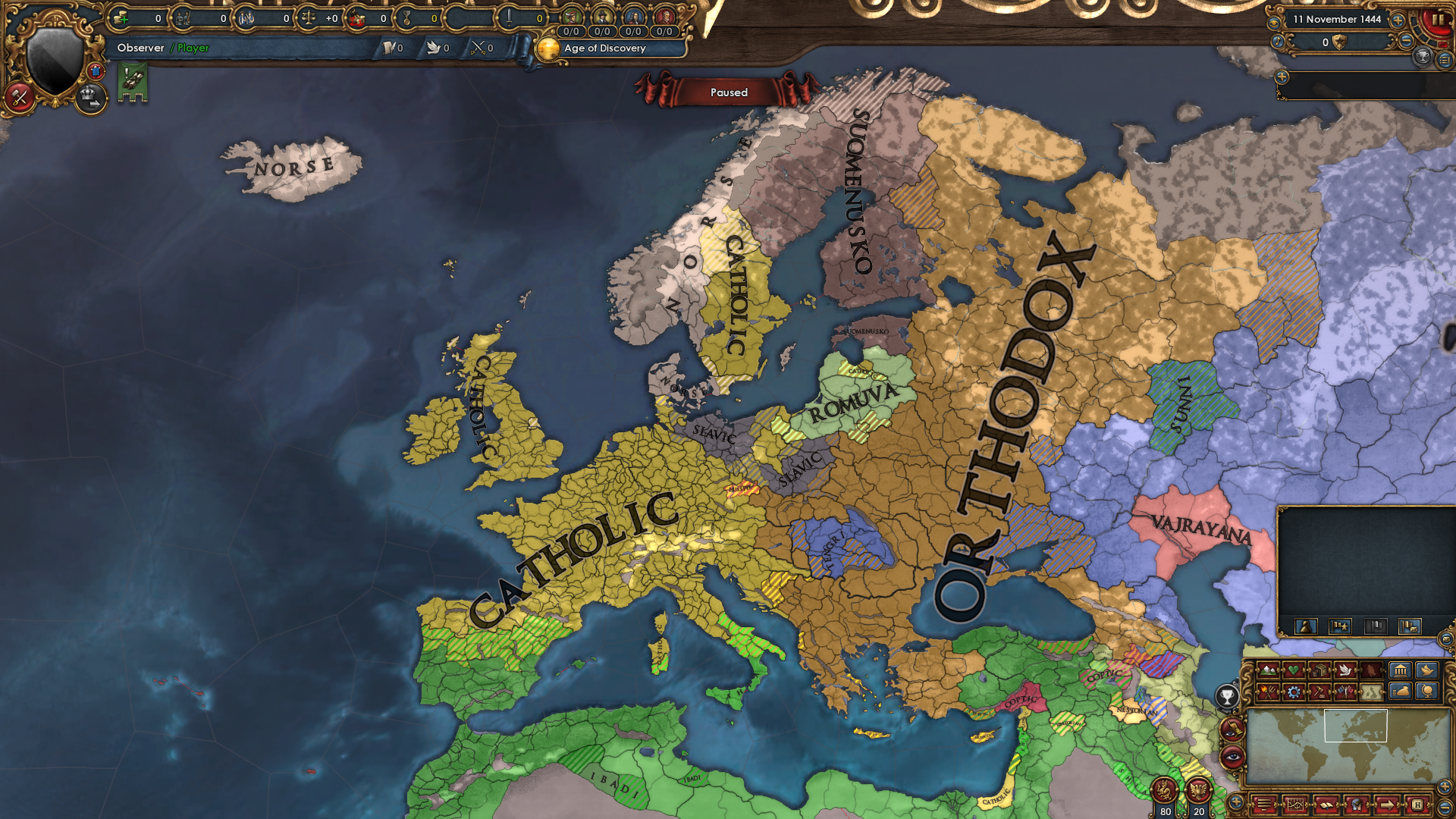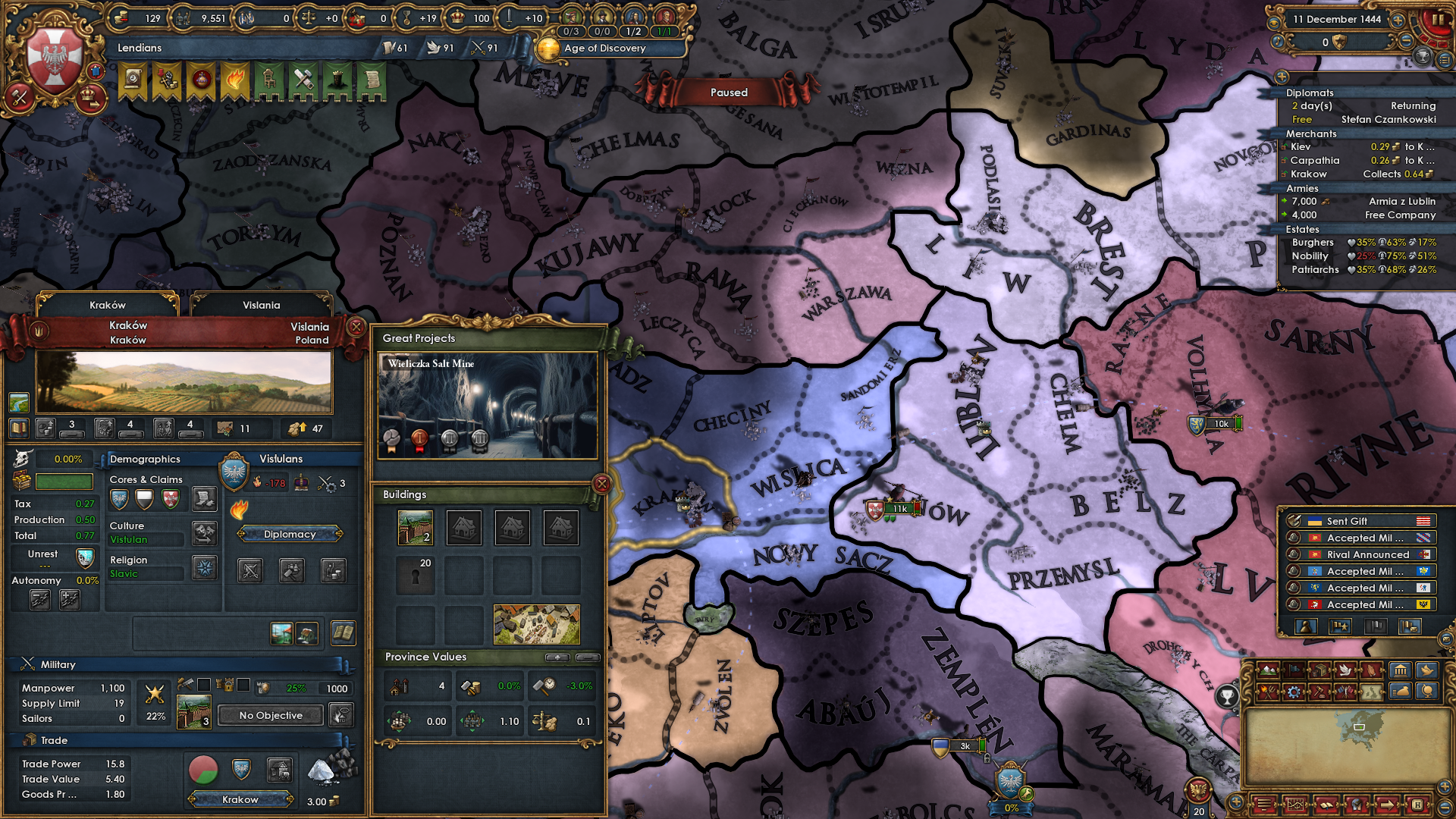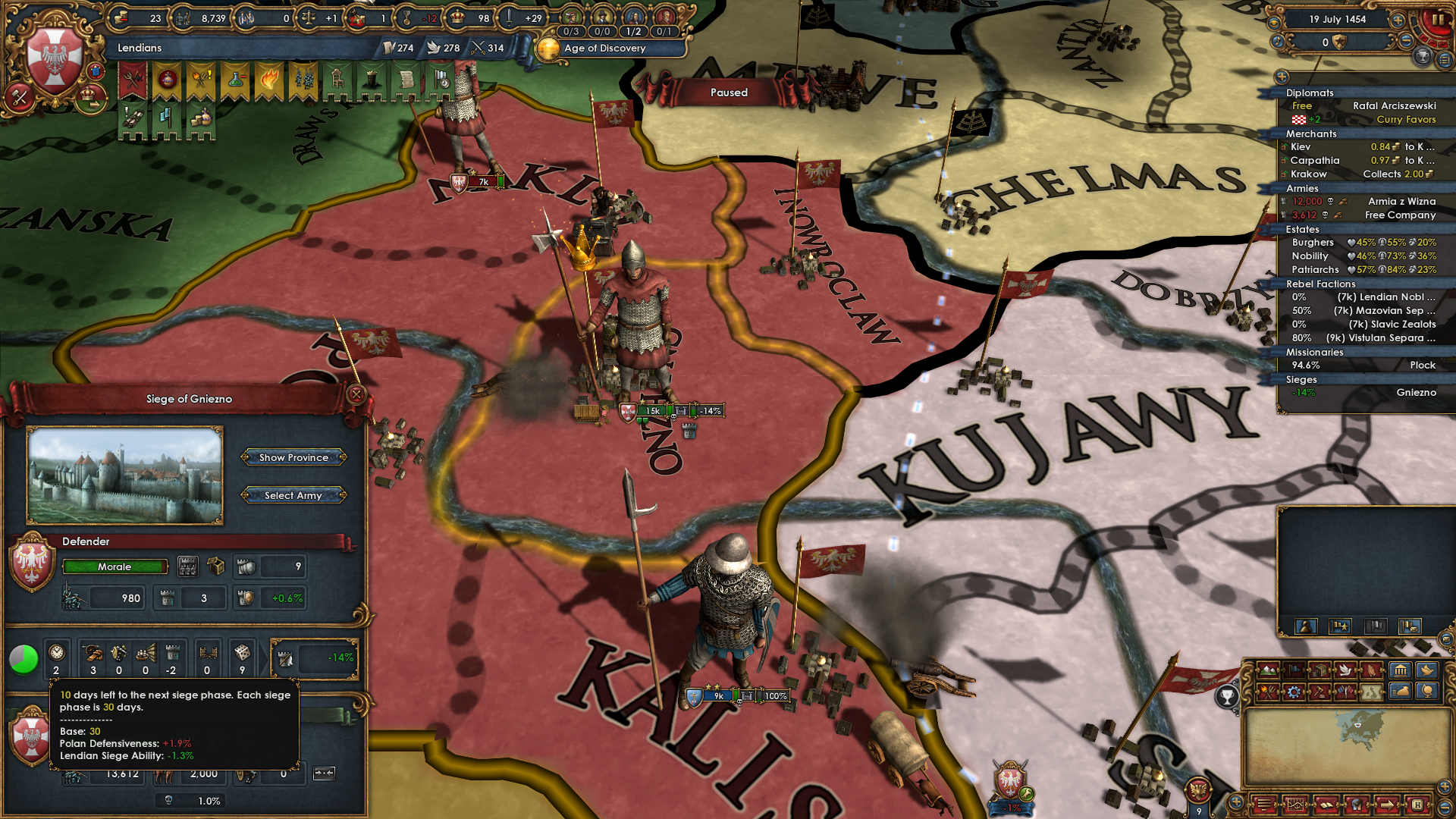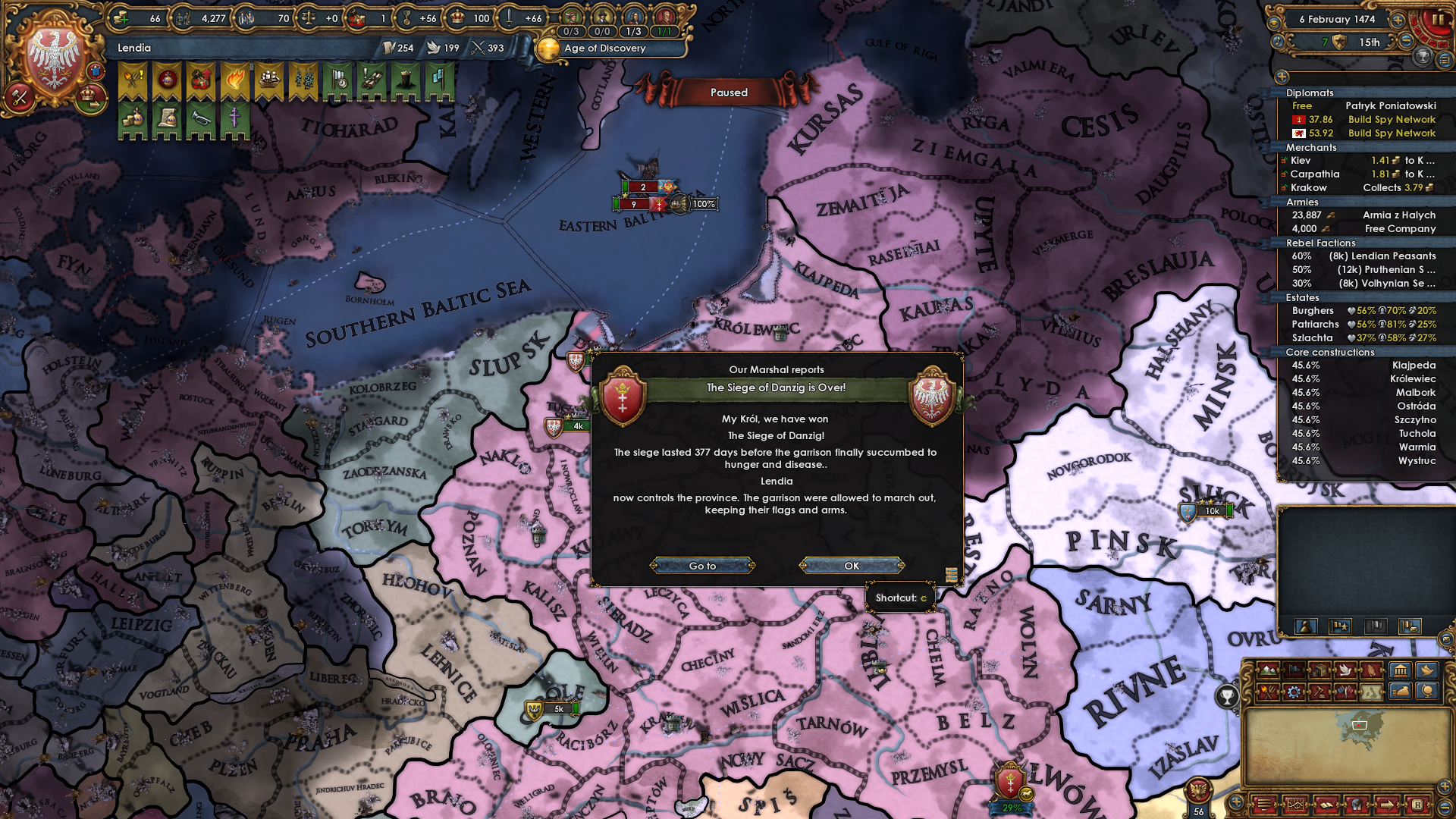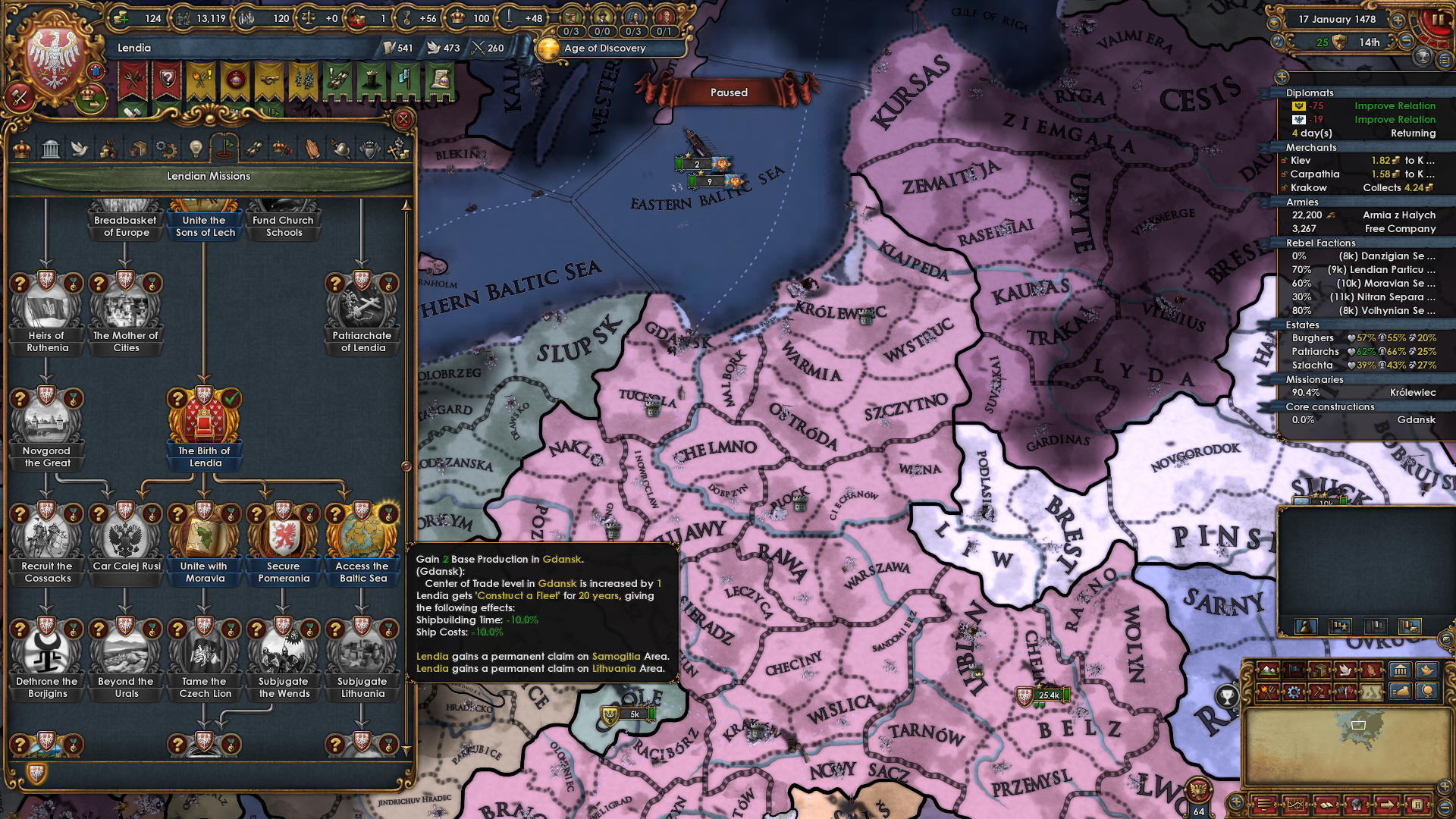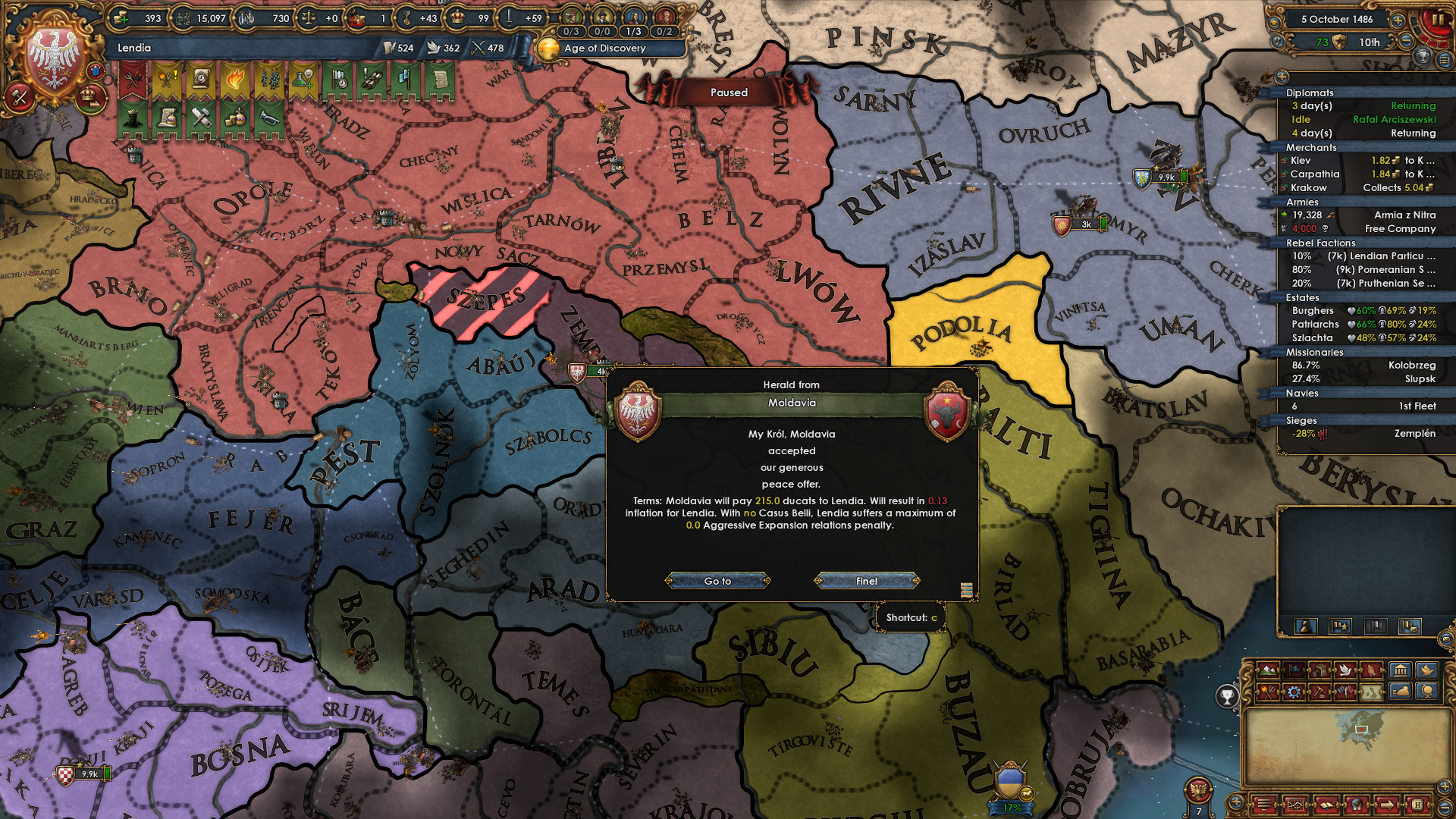Chapter 1: The Lendish Wars of Reunification
So a quick side note, my silly self forgot to save right before declaring the first war at the end of the setup chapter. I wound up losing my 4 siege general which isn't great but it's not majorly game breaking.
December 11, 1444. An emissary of Ksiaze Boleslaw arrives at the court of the Vistulans with a formal declaration of war.
"For far too long have the faithful servants of Christ suffered under the heathen yoke. We have tried peacefully to resolve the situation, yet you persist in your idolatry and persecute our brethren. No longer shall these injustices stand... let it be known that the only acceptable recourse is the total surrender and subjugation of the Vistulans."
Thus began the Wars of Lendish Reunification. The Ksiaze himself personally leads the army to Krakow, the fortified capital of the Vistulans.
Krakow is a valuable province, boasting some of the richest salt mines in Europe. It is thanks to these mines that the Vistulans have avoided subjugation. However, even the salt of the earth cannot save them from the judgement being passed upon them.
The commander of the Vistulans army, Aleksander Karol, attempts to siege Lublin while the Lendish army sieges Krakow. Boleslaw and his new general, Stanislaw Malachowski, quickly march the army away from Krakow and descend upon the Vistulans at Lublin. The result is a catastrophic loss for the Vistulans - their morale completely shatters. Invigorated by this decisive victory, the Lendish army lays siege to all the provinces east of Krakow. In the coming months, the Vistulans will desperately try to rebuild their army strength in their northwestern provinces, but it will not be enough to defeat the Lendians.
Sensing the weakness of the Vistulans, King Slavomir II Mojmir of Moravia also declares on the Vistulans, hoping to expand his realm. This incident contributes to the end of the Lendish-Moravian alliance, as it becomes clear that both desire the conquest of Poland.
The siege of Krakow begins properly in earnest. Thanks to the salt mines, the city is rather defensive, but it is clear that they cannot hold out forever. Boleslaw bides his time; he knows siege warfare, and his knowledge, combined with God's help, will surely starve out the pagans.
The Nobility, seeing the Ksiaze's occupation with the war, take the opportunity to demand higher pensions in exchange for their support. The Ksiaze furiously agrees to it, hurting the crown's tax income. He cannot afford to anger the estates at this critical juncture, for they could easily destroy his efforts to unite the region.
It comes out that Boleslaw's loins had indeed gotten the better of him. He was found of having sired a son with Jadwiga Gosiewski, the daughter of a prominent noble family seated in Chelm. The shrewd family took the opportunity to force the Ksiaze to wed their daughter and grant them extensive privileges to ensure that, at least for the rest of his reign, their realm would become powerful in the growing kingdom.
Young Stanislaw had minor administrative skills, masterful diplomatic ability, but no military ability whatsoever. Boleslaw was quite disappointed, and resolved to find a way to disinherit him as soon as the war was over. He knew that the realm would need a strong military mind to succeed in the years to come.
Krakow falls to Lendish forces on April 20, 1446. The Ksiaze wastes no time to descend upon the rebuilt Vistulans army and to utterly crush them.
The Treaty of Lublin-Krakow is signed on May 18, 1446. The Vistulans, utterly crushed, agree to full annexation.
The Ksiaze arranges for some of the economic resources of Vislania to be concentrated back into the capital state of Lendia before beginning the process of properly coring the newly acquired land. As a result of the war, the Krakow Salt Mines are damaged and thus closed down. It will take quite some time before the Crown has the resources to restore it.
The Metropolitan of Kiev, seeing our success against the heathen, offers us an alliance. The Ksiaze accepts; the Metropolitan is the strongest Orthodox authority north of the Ecumenical Patriarch in Constantinople and an alliance would certainly legitimize our right to unite Poland.
On September 6, 1446, the Ksiaze issues a formal declaration of war to the Mazovians, the other pagan tribe in the region. Their alliance bloc is weaker than that of the Polans, who allied Carinola. In addition, Boleslaw hopes that by defeating the Mazovians the moral authority of the idolators will be crushed, allowing for easier efforts in catechizing and baptizing the wayward pagans. Moravia is called in to help deal with the Silesians.
The Siege of Plock begins straightway. Their fortifications are not as strong as Krakow, allowing for more rapid siege progression.
Plock falls at the beginning of May. Following this, the Lendish army descends upon the combined armies of the Mazovians and the Silesians, utterly crushing them by the month's end.
The Siege of Raciborz, the capital of the Silesian tribes, finally falls on June 1, 1448. However, the Kingdom of Bohemia, disgraced after the Hussite Wars, has taken advantage of the Silesian weakness to declare on them, hoping to take their land and convert them to Catholicism to re-enter the Emperor's good graces.
Vistulans loyalists, hoping to take advantage of the war to restore their independence, rise up and attack the Moravian army in Krakow. This is a foolish mistake, as the entirety of the Christian alliance bloc descends upon the heathens, utterly crushing them.
On June 28, 1448, the Mazovians formally surrender to the Lendians and accept the demands for full annexation. In addition, the Silesians cede Raciborz to Moravia. At last, at long last, the heathens have been conquered. Poland is now a Christian land - though it is still not yet united, for the Latin heretics of Greater Poland still lie outside Lendish rule.
There is much rejoicing in Lendians today, for the pagans have been purged, their tribes annexed! The Church in particular thanks the Ksiaze for his military efforts - they are emboldened by the Crown's backing and can begin in earnest the conversion of the heathens. Their efforts are further aided by the complete collapse of Slavic pagan fervor - Perunn has been decisively defeated by Christ.

Unfortunately, Boleslaw's ambitions to unite the Sons of Lech are frustrated upon learning that the Polans have signed an alliance with Moravia. The Ksiaze is outraged, and considers this to be treason of the greatest order. However, he is no fool - the conquest of Polans will have to wait. For now, the focus is on consolidating the new gains. The Piasts failed in the past because they did not achieve internal stability and religious cohesion - Boleslaw is determined to not make that mistake. The next few years will be dedicated to coring the new provinces, baptizing the heathens into the Orthodox Church, and putting down rebellions. Stability is paramount.

During this period of stabilization, the Burghers offend the Patriarchs and both parties demand the Ksiaze resolve their issues. At the time, Boleslaw favors the Patriarchs. He needs their support to continue the Christianization of Poland - and his support of the Patriarchs also weakens the strong position the Burghers currently enjoy.
The peacetime also allows Boleslaw to quietly disinherit Stanislaw.
Boleslaw's victories over the heathens has led to the development of a new military tactic, the Pike Square. Having first been experimented with against the Vistulans, the victory over the Mazovians has given the Ksiaze the confidence to make this the new standard military tactic of his army.
In 1449, the Ksiaze is able to implement new legal and regional infrastructure to better facilitate trade in his realm. These new marketplaces use the Grand Markets of Lublin as their model.
Beginning in 1450, a Renaissance spurred on by the rediscovery and reapplication of the ancient Roman and Greek classics begins, its origins in Constantinople. These ideals will rapidly challenge all aspects of society - and any Ksiaze worth his salt will have to consider them.
Mazovian separatists revolt in Plock, but they are quickly put down. The Ksiaze will suffer no resistance in his goals to baptize the Sons of Lech.
The Ksiaze makes good on his promise to the Burghers to invest in the markets of Belz.
A new Diet is convened, and the Ksiaze gives preference to the Patriarchs who wish to convert the unbelievers. If the Ksiaze can convert the heathens of Ciechanow to Orthodoxy, they will provide an Inquisitor to further aid the conversion efforts.
The Carolginians of Francia have lost the Emperorship, and the new Emperor in Brabant wishes to expel them from the Empire. Such a move would cause the Empire to greatly weaken, and the Ksiaze watches carefully, seeking a potential opportunity to expand into Bohemia in the near future.
Ciechanow is converted, and as promised the Inquisitor Bartlomiej Melszlynski agrees to aid the Ksaize in the baptism of the Sons of Lech - at a discount, no less!
Francia is expelled from the Empire and immediately retaliate by declaring the War for the Imperial Throne. The whole Empire will soon be embroiled in this conflict, and Boleslaw monitors the situation carefully.
Boleslaw's efforts to Christianize the realm have gained him the support of the Patriarchs. With their backing, the faithful men of Lendians flock to the banner, eager to fight the realm's just wars.
The Magyars attack Moravia, who appeal to the Lendians for aid. Boleslaw smells an opportunity - the Magyars could weaken Moravia enough that they would not honor their alliance with Polans. As a result, the Ksiaze declines the call to arms, ending the alliance and starting a bitter rivalry.
The Moravians are replaced by the Croatians. While the Ksiaze doesn't like allying with Latin heretics, he needs their military alliance to ward off potential threats while his kingdom is still in its cradle.
By July 1454, the Moravians are no longer willing to aid Polans and so Ksiaze Boleslaw IV declares the final war to reunite the realm. The Polans are still aided by the Carinolans, but the Lendians receive help from their allies in Turov. Immediately the Lendish army begins the Siege of Gniezno, the Polans capital.
The Lendish heir, Zygmunt Kazimierz, is born. He will be an above average administrator, a terrible diplomat, but a military genius - the person Boleslaw needs to succeed him.
On April 9, 1456, the Treaty of Gneizo-Lublin is signed. The Piasts of Polans surrender completely to the Lendians, their realm fully annexed. At last, at long last, the Sons of Lech are united once more! There is much celebrating and feasting to be had in Lublin for weeks afterwards.
It takes over a year for the new territories to be cored up. In that time, the last pagans are baptized into the Orthodox faith and while there are some revolts, they are quickly put down. New developments in the construction of churches are made, and early modern financial instruments are developed to help with ensuring the realm's ledgers are accurate.
On July 13, 1457, after nearly 5 centuries, the Sons of Lech become united once more.
The newly reunified realm looks back with grand church services dedicated to Sts Cyril and Methodius, the Emissaries to the Slavs, while also beaming with pride that they have avoided the errors of Mieszko Piast's failure 5 centuries ago. The Lendians even take to calling the entirety of this resurgant kingdom "Lendia" as a mark of national pride - something that the rest of the kingdom agrees with.
Boleslaw makes an order to unify the disparate tribes into one unified culture, aiming to break down tribal identities that divided them for so long. From this point forward, all are Sons of Lech, all are (or will be) Orthodox Christians, all will be part of the Kingdom of Lendia!
Of course, this is only the beginning. The remaining Slavic pagans are angered and outraged at this new Christian Lendia. The Romuvans to the north shore up their defenses. The Holy Roman Empire's war rages onwards, and the Heirs of Ruthenia present tempting targets. Why stop now, the Estates ask Boleslaw. Let us forge a new Empire, an Orthodox Empire, one that rivals or even exceeds Rome? The world is our oyster!
Boleslaw smiles and turns to his wife. Yes, they raise good points. There will be time in the near future to expand. But for now, after 13 long years of war, after 5 centuries of disunity, the Sons of Lech are one once more.
And that is cause for celebration.
